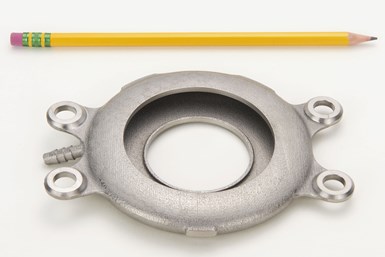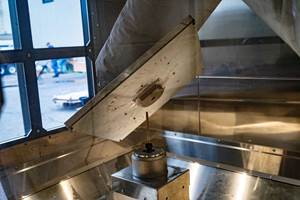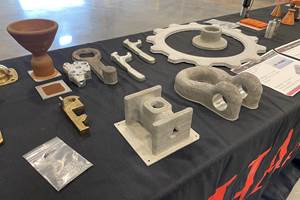ATI to Establish Additive Manufacturing Facility to Serve US Navy
ATI will utilize its metal additive manufacturing and machining capabilities as part of contract with Bechtel Plant Machinery Inc. (BPMI) to support the U.S. Navy.
ATI created an oil collector for a customer that was seeking performance improvement by adding a part that did not already exist within these helicopters. The lightweight part was delivered faster and made more easily via electron beam melting (EBM) than a conventionally manufactured alternative could be produced, while also illuminating a way forward for upgrading other existing systems. Photo Credit: ATI
ATI Inc. has been awarded a contract by Bechtel Plant Machinery Inc. (BPMI) to support development of highly engineered part solutions in support of the U.S. Naval Nuclear Propulsion Program. To support the contract, which calls for advanced manufacturing methods including metal additive manufacturing (AM), ATI will establish a dedicated additive manufacturing facility outside Fort Lauderdale, Florida.
ATI will expand upon its traditional capabilities, bringing expertise as a global producer of high-performance materials and solutions to AM for aerospace and defense. ATI Additive Manufacturing Products will include advanced large-format metal AM, heat treating, machining and inspection capabilities within a secure facility. It is designed for expansion as ATI continues to extend its AM technologies to the assembly of finished components.
The new operation brings together the expertise of ATI forged products, known for producing mission-critical, finish-machined forgings, with the powder alloy leadership of ATI specialty materials. “With this facility, ATI will maximize its ability to deliver advanced additively manufactured materials and components by turning them into parts that further the defense industry,” says Kim Fields, ATI president and chief operating officer. “Our customers increasingly require more robust and versatile materials and components, produced in an ecologically sustainable manner. This facility will deliver both.”
The facility is projected to come online in mid-2024. “Within one facility, we’re combining the latest additive and advanced manufacturing technologies, and ATI’s novel powder alloys,” Fields says. “We bring decades of experience delivering solutions that power and protect. We’re well-positioned to deliver the next generation of manufactured components.”
AM has advanced beyond rapid prototyping to the manufacturing of structural and functional components. “Additive manufacturing offers tremendous advantages to our program, including accelerating ship construction, improving operational readiness, reducing costs and an increase in warfighting capability,” says Barb Staniscia, BPMI president and general manager. “Metal additive manufacturing is driving necessary improvements in lead time, design and performance for the U.S. Navy.”
ATI strives to partner with its customers to deliver materials that enable great achievements. “As our customers blaze the trail of what’s possible, ATI is honored to partner with BPMI in developing and producing the materials and components that make these extraordinary achievements possible,” Fields says.
- Read about Allegheny Technologies Inc.’s (ATI) task to build an oil collector for a fleet of legacy helicopters. The lightweight part was delivered faster and made more easily via electron beam melting (EBM) than a conventionally manufactured alternative could be produced, while also illuminating a way forward for upgrading other existing systems.
- Watch this episode of The Cool Parts Show which features ATI’s oil collector for legacy helicopters. AM editors discuss the oil collector at the 8:17 minute mark.
Related Content
The Cold Spray Solution to the Casting, Forging Supply Chains
Startup HAMR Industries performs additive manufacturing work at Neighborhood 91 that provides an alternative to traditional casting and forging. Success so far has led to redefining the limits of its additive equipment.
Read MoreFor Coast Guard, AM Adoption Begins With “MacGyver-ish” Crew Members Who Are Using 3D Printing Already
AM suits the Coast Guard’s culture of shipboard problem-solving, says Surface Fleet AM lead. Here is how 3D printers on ships promise to deliver not just substantial cost savings but also an aid to crew capabilities and morale.
Read MoreVideo: 5" Diameter Navy Artillery Rounds Made Through Robot Directed Energy Deposition (DED) Instead of Forging
Big Metal Additive conceives additive manufacturing production factory making hundreds of Navy projectile housings per day.
Read MoreNeighborhood 91 Expands, With Metal Powder Works and HAMR Now Open
Ribbon cuttings for the Pittsburgh campus's newest tenants coincided with the announcement that a DOD-funded resilient manufacturing program will also be developed at the site.
Read MoreRead Next
Alquist 3D Looks Toward a Carbon-Sequestering Future with 3D Printed Infrastructure
The Colorado startup aims to reduce the carbon footprint of new buildings, homes and city infrastructure with robotic 3D printing and a specialized geopolymer material.
Read MorePostprocessing Steps and Costs for Metal 3D Printing
When your metal part is done 3D printing, you just pull it out of the machine and start using it, right? Not exactly.
Read MoreCrushable Lattices: The Lightweight Structures That Will Protect an Interplanetary Payload
NASA uses laser powder bed fusion plus chemical etching to create the lattice forms engineered to keep Mars rocks safe during a crash landing on Earth.
Read More





















